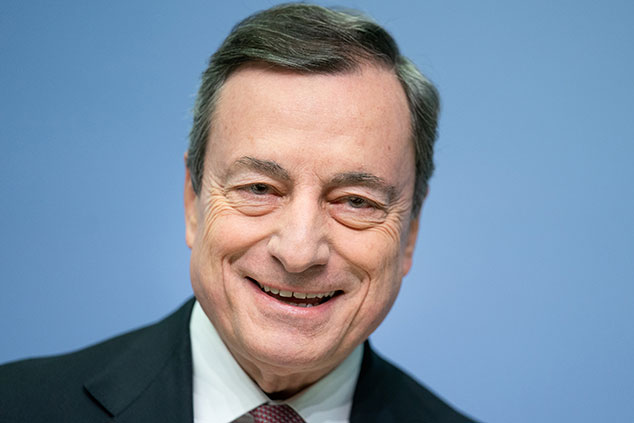
This article is taken from our FREE daily investment email Money Morning.
Every day, MoneyWeek’s executive editor John Stepek and guest contributors explain how current economic and political developments are affecting the markets and your wealth, and give you pointers on how you can profit.
Anyone who’s read Money Morning for any length of time might have guessed I’m not a fan of central bankers.
But I have to give Mario Draghi, boss of the European Central Bank (ECB), my grudging respect. He has a genuinely tough job. The ongoing survival of the euro really is in no small part down to his skilful poker playing and diplomatic wrangling.
Trouble is, his job is only half-done. He’s papered over the cracks, but the gaping chasms in the eurozone financial system are still there. And he’s out of time – he leaves this year.
So how is he likely to handle his succession, with European growth slowing fast?
Well, one thing’s for sure, he doesn’t seem likely to raise interest rates soon. So the answer might be bullish for stocks, at least in the short term.
Everyone is gloomy or jittery – but central banks could change that
Earlier this week, Merryn and I recorded this week’s MoneyWeek podcast. Regular readers and listeners will know that we have a tendency towards bearishness. Yet this week we were discussing the potential for a “melt-up” in markets.
It’s interesting that it has really only taken the hint of a slowdown in growth for everyone to immediately be reaching for their recession forecasts. And it’s interesting that, as Merryn points out on the podcast, companies that warn on profits are being punished (in terms of average percentage share-price fall) even more harshly than they were back during the financial crisis.
And of course, it’s interesting than on both sides of the Atlantic and in many other parts of the world, people are so blinded by partisan politics, that they can’t help but want to believe that disaster is coming our way any minute now.
In effect, the mood among investors is so gloomy – or at least, they seem so very jittery and so prepared for the worst to happen – that it might not take that much good news for markets to perk up.
One element of that potential good news could be the increasing reluctance or even inability of central banks to raise interest rates or to tighten monetary policy any further.
In the US, we’ve already seen Jerome Powell tone down his rhetoric a bit. And with the US shutdown continuing for so long now, it can’t help but have some sort of effect on US economic growth figures this quarter (which has, in recent years, consistently been a deceptively dud quarter anyway).
So even as employment data continues to be positive in America, the Fed has every excuse it needs to avoid raising interest rates any further. We might even see a slowdown in its rate of quantitative tightening (or money burning, as I prefer to call it).
In the UK (which only really matters to those of us living in the UK, to be fair), the Bank of England is paralysed by Mark Carney’s somewhat ropey “forward guidance” skills and his inability to process Brexit as anything other than a world-shaking disaster. So it might take a while for rates to move here too (especially if Brexit gets pushed further out along the horizon).
China – which does matter – is also battling a slowdown. For all its apparent intentions to crack down on dodgy credit, it may well decide that flooding the hole where liberalisation policies should be with huge amounts of cash is by far the easiest way to get the economy going again.
And then there’s Europe.
The European Central Bank isn’t raising rates this year
The European Central Bank (ECB) downgraded its growth outlook for the eurozone yesterday at its latest meeting. Mario Draghi had been hoping to get at least one interest rate rise under his belt before he leaves the role at the end of October this year. But it looks like his chance has gone.
Particularly as it’s also worth noting that two of the top candidates to replace Draghi were pretty cagey about the prospect of raising rates at all this year when asked about it at Davos. Markets now think that there won’t be a rate rise until 2020, a perception which Draghi encouraged.
And while the ECB has now ended quantitative easing (QE), it looks as though there’s a good chance that there will be an extension of the TLTRO (targeted longer-term refinancing operations) scheme. I won’t even begin to unpack that acronym – all you need to know is that it’s a way of giving cheap loans to struggling eurozone banks.
It’s likely to be needed because a lot of the loans dished out to Italian banks in particular during the last round of TLTRO are due to be repaid this year. If they don’t get rolled over, it could get tricky, and it would also represent a big dollop of monetary tightening. So the ECB can easily justify another round if it has to.
In short, central banks around the world spent last year tightening monetary policy or warning markets that it was going to be tightened. As a result, 2018 was pretty grim.
This year, it’s looking as though central banks are sufficiently rattled to pause or even reverse that tightening. If the Federal Reserve in the US next week confirms that it’s going to take a breather, then it could tip the balance and convince markets that central banks have got their backs again.
Let’s see what happens. But don’t be surprised if the current tentative rally has legs.
PS Don’t forget to get your ticket for our event on 12 February, where I’ll be talking about melt-ups, Brexit and trade wars with Tim Price and Iain Barnes of Netwealth. Book here now.